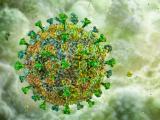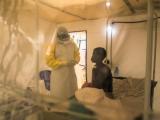A World Health Organization (WHO) emergency committee convened in the wake of imported Ebola cases in Uganda said today that the situation still doesn't warrant a public health emergency of international concern (PHEIC), but they did express serious worries about the threat to the Democratic Republic of the Congo (DRC) and its neighbors and over a lack of funds.
In a statement released at the end of its deliberations—the third time the group has met since the outbreak began last August—the committee said the cluster of cases in Uganda isn't surprising, and the country's rapid response underscores the importance of preparedness in neighboring countries.
Though the outbreak is a health emergency in the DRC and the immediate region, it doesn't meet all three criteria for a PHEIC under the International Health Regulations (IHR). And the experts say that formal temporary recommendations under the IHR would not enhance current response operations.
Risk of global spread still low
In a statement, WHO Director-General Tedros Adhanom Ghebreyesus, PhD, said though the spread of Ebola to Uganda is a new development, it doesn't signal a shift in outbreak dynamics.
"We have the people, the tools, the knowledge, and the determination to end this outbreak," he said. "We need the sustained political commitment of all parties, so we can safely access and work with communities. We also need the international community to step up its financial commitment to ending the outbreak."
Tedros is in Kinshasa today meeting with top officials in the DRC and will next visit the outbreak region before traveling on to Uganda to assess the latest developments.
At a media telebriefing today, the committee's acting chair, Preben Aavitsland, MD, senior consultant and infectious disease specialist at the Norwegian Institute of Public Health, said the group concluded that the risk of international spread is still low and that there is nothing to gain by recommending a PHEIC. He added that there was potentially a lot to lose in declaring a PHEIC, such as the risk of airlines stopping flights, border closures, or other restrictive measures that could hurt the DRC's economy.
To declare a PHEIC as a means to raise funds for the outbreak response would be a misuse of the process, health officials said.
Deep concerns over funding
Aavitsland said committee members are deeply disappointed that the WHO and its response partners haven't received enough funding and resources to battle Ebola. Currently, $98 million is needed to support the response through July, but so far health officials have received only $43.6 million, resulting in a $54 million gap.
Mike Ryan, MD, the WHO's executive director of emergency programs, said there has been very little funding available to help the DRC's four closest neighbors prepare for imported Ebola cases—and there's still a $27 million shortfall in that support.
In its recommendations today, the emergency committee also tweaked its public health advice, including a recommendation that countries most at risk put approvals in place for investigational medicines and vaccines.
Uganda monitoring 4 suspected cases
A 3-year-old boy who is one of Uganda's recently confirmed Ebola cases and three members of his family are back in the DRC where experimental treatments are available, and there are no active cases in Uganda, according to the latest updates from the WHO and Uganda's health ministry.
Four people with suspected infections, however, are still in Uganda and are receiving care at the Bwera Ebola treatment center, and 98 contacts are being monitored.
At today's media briefing, Ryan said ring vaccination in Uganda is expected to begin tomorrow, now that health officials have a comprehensive list of contacts and contacts of contacts who are eligible to be vaccinated.
In a statement yesterday detailing the Ebola events in Uganda, the WHO said health workers at both facilities where Uganda's first imported case, involving the 5-year-old boy, was treated, had been previously vaccinated.
WHO officials added that, since Nov 7, Uganda has vaccinated 4,699 healthcare and frontline workers as part of its Ebola preparedness activities and noted that nine Ebola treatment units are in place in districts that border the DRC's Ituri and North Kivu provinces.
Given the close epidemiologic links of Uganda's three cases and its high level of preparedness, the WHO said the overall risk to the country is moderate and the risk posed to the region by the new cases in Uganda—with no signs of local transmission at this point—is low.
DRC total rises by 12
The DRC's health ministry today confirmed 12 more Ebola cases, raising the total to 2,120. Two of the cases are in Biena, an earlier affected area. The others are in Mabalako, Kalunguta, Rwampara, and Mandima. Health officials are still investigating 322 suspected cases.
Nine more people died from their Ebola infections, two in community settings and seven in Ebola treatment centers. The deaths push the outbreak's fatality count to 1,420.
In its weekly snapshot of Ebola activity in the DRC yesterday, the WHO said cases are declining in some hot spots such as Katwa, Beni, and Kalunguta, but continue at a moderate pace in others, such as Mabalako and Butembo.
"Recent community dialogue, outreach initiatives, and restoration of access to certain hotspot areas have resulted in some improvements in community acceptance of response activities and case investigation efforts," the WHO said.
Health officials are still worried about persistent delays in detecting cases and the many Ebola deaths in the community, which raise the risk virus spread. About one third of Ebola patients are dying outside of transit centers or Ebola treatment centers.
Also, the WHO said cases continue to rise among health workers, with 118 infected so far.
Boosting vaccine production
WHO officials said today that Merck, which makes the VSV-EBOV vaccine, recently announced plans to begin producing the vaccine at its facility in West Point, Pennsylvania, in addition to its facility in Germany.
At the WHO media briefing today, Ryan said WHO officials welcome the new development, which will double vaccine capacity.
Currently, the company has 250,000 doses ready to ship and expects to make 100,000 more by the end of the year.
See also:
Jun 14 WHO emergency committee statement
Jun 14 Tedros statement
Jun 13 WHO second situation report on Ebola in Uganda
Jun 13 WHO statement on Ebola in Uganda
Jun 14 DRC update


















